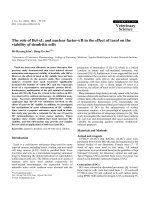Business Change - The Roles of Change Agents and Subject Matter Experts in Organization Change potx
Bạn đang xem bản rút gọn của tài liệu. Xem và tải ngay bản đầy đủ của tài liệu tại đây (1.1 MB, 291 trang )
Business Change - The Roles of Change Agents and Subject
Matter Experts in Organization Change
And Much More…
101 World Class Expert Facts, Hints, Tips and Advice On
Change Management
Copyright ©
Notice of rights
All rights reserved. No part of this book may be reproduced or
transmitted in any form by any means, electronic, mechanical, photocopying,
recording, or otherwise, without the prior written permission of the publisher.
Notice of Liability
The information in this book is distributed on an “As Is” basis without
warranty. While every precaution has been taken in the preparation of the book,
neither the author nor the publisher shall have any liability to any person or
entity with respect to any loss or damage caused or alleged to be caused directly
or indirectly by the instructions contained in this book or by the products
described in it.
Trademarks
Many of the designations used by manufacturers and sellers to
distinguish their products are claimed as trademarks. Where those designations
appear in this book, and the publisher was aware of a trademark claim, the
designations appear as requested by the owner of the trademark. All other
product names and services identified throughout this book are used in editorial
fashion only and for the benefit of such companies with no intention of
infringement of the trademark. No such use, or the use of any trade name, is
intended to convey endorsement or other affiliation with this book.
Business Change - The Roles of Change Agents and
Subject Matter Experts in Organization Change
And Much More… - 101 World Class Expert Facts,
Hints, Tips and Advice on Change Management
Information is power – you know that. However, how do you research
the best Change Management strategies, without spending too much of your
time (and money) on it? The average person earns $ 1100 per week, which
equates to $ 27 per hour. Trying to do the research yourself would take you at
least 5 hours to come up with the best information, AND you’ll have to do this
on a regular basis to come up with the most up to date and current information.
There has to be a different way to find the info you want! Well, yes there
is… we did all the research for you, combed through all the information and got
down to the hard core of the 100 most up to date and best Facts, Hints, Tips and
Advice here, in this book.
The 101 of the most current, most actual and beneficial Facts, Hints,
Tips and Advice you can find from experts in the field on Change Management
Table of Contents
Access Your Present Self & You Will Find it Rich 11
Understanding the Various Aspects of Change Management 13
The Fallacy of the Status Quo 16
The New Physics of the Workplace 18
Increase Sales - A Clear Signal to Sell More 20
What to Do When You're Put in Charge of Change 22
Structuring Your Work to Deliver Customer Value 24
Management's Wrong Decisions During an Economic Downturn
29
Business Change - The Roles of Change Agents and Subject Matter
Experts in Organization Change 30
Successful Change Management Tips 31
Continuously Improve Your Business Using Kaizen Principles 33
Do Old and Matured Organizations Need ERP 35
ESI - Executive State Identification 37
Whipping Healthcare Into Shape 40
The Launch of AS9100 Rev C Will Make Firms More Competitive
41
5 Elements of Business - How to Look at Business Growth With an
Alternative Eye 46
Change Management and CRM 48
Some Pretty Good Ps for Initiating Change 50
Change = Progression 56
Self Leadership - Authenticity Has to Be Genuine 57
Finding a Healthy Work Life Balance Requires Real Change 59
Exposed - How You Can Start Risk Management on a Beer Budget
Today 61
Leading and Managing the Corporate Culture 62
Business Change - The Future of External Staffing in Business
Change 68
Batten Down the Hatches - Do We Ever Learn? 69
Trinidadian Executives - Up Against Them in Jamaica 71
Confronting Project Management Challenges by Adding a Project
Management Consulting Firm 74
The Phased Approach to Project Management Implementation 77
Dealing With a Resistant Individual 82
Comfy 'Jammies and Warm Fuzzy Slippers 84
Monkey Business - Better Business Practices Learned Through
Monkeys Number 28 86
Coping With Volatility in Your Business 88
Are You a Change Champion? 89
How to Guide Staff Through Stressful Times - The Six Key Steps
You Need to Take 93
Tracking Change - Identification & Categorization - Part II 95
Tracking Change - Identification & Categorization - Part I 98
Change Mastery - Bulletproof Jacket - An Unflappable State -
Keeping Your Heart Open in Hell 100
Change Mastery - The Time For Change is Before Discomfort
Turns to Disaster 102
How Companies Benefit From Workplace Diversity Training 104
Four Keys to Change 106
Change Mastery - Being Real at Work - The Fastest Path to Inner
Peace at Work 111
Q&A - Richard Payne, BBC 114
Successfully Dealing With Change - Embracing Chaos As the
Natural Order 120
Setting Goals With Lean Thinking 121
Change Leadership - The Keys to Success 122
UCME 1X 127
Small Business Change Management 128
Corporate Tai Chi Now - 7 Elements to Show Why Five-Minute
Corporate Tai Chi is Profitable Now 131
Managing Change - An Occupational Health and Safety
Perspective 134
How to Lead and Influence Change 136
Yet, I'm Servicing a New Generation 139
An Invitation to Change 140
Work Smart - Live Long 142
Got Business Acumen? What is It? Why Do I Need it and How Do
I Get It? 146
Stop Fixing the Blame - 5 Steps to Effective Problem Resolution149
Motivating Change - Resistant Employees 151
Consciousness at Work - A Personal Survey 154
Are You Voting For Change? Be Careful What You Ask For 158
The Runaway Project of Doom 160
Change Management Or How Progress Wrecks Everything 162
Hard Measures - Consolidate & Quantify 163
Ask Customers Before You Change 166
Change - Ask Customers Their Opinion First 167
Be Ready For Change 168
What to Do When Change Happens 169
ISO 9001 - 2008 - Hidden Business Opportunities - An
Opportunity to Reenergize Your QMS 172
It's Not All About the Tech - People Are Part of the Process 176
Managing Change in the Workplace 178
No Bail Out - Start Planning Your Outcomes Now 179
Change Your Strategy, Change Your Results 181
Recruiting Firm Owners - Explode Your Revenues - Change the
Planning Process 184
Employee Engagement and Profitability 188
Leadership Lessons For Uncertain Times - Lessons For Leaders
From We Are Marshall 190
Is Imagination More Important Than Knowledge? 194
Making Change Last - How to Get People on Board 196
When Change is No Longer a Dirty Little Word 200
Economic Uncertainty Causes Workers to Quit-&-Leave and Quit-
&-Stay 203
Things Do Not Change - We Do 207
Change Acceleration - Ten Steps to Implement Change Faster 213
Creating a Culture of Workplace Accountability 215
ERP White Paper is the Key in Dealing With Change 217
Should Employees Have Any Say in Business Decisions 218
Leadership Coaches - 10 Signs of Leadership Gone Wrong 219
Overcoming Resistance to Change 221
Top 5 Questions About Implementing Open Innovation 222
Personal Development For Entrepreneurs - Your Biology Wants to
Prevent You From Making Changes 226
An Air Battle - On the Ground 227
Do We Really Need to Go All the Way to the Top? 231
How to Develop a Business Owner Mentality With Your
Employees 233
The Error Proofing Component of the Change Management
Toolset 239
Change Management - Times of Increased Failure Risk in the
Wake of Economic Meltdown 242
Two Steps For Change 243
Five Principles For Leading Organizational Change 246
You Don't Need a Vision 249
Employee-Consultant Frictions 250
The Hunt For Opportunities 251
The Top-Down Approach to Organisational Change 255
How Can You Find the Seeds of Opportunity For 2009? 257
Structure Your Business For the Future 258
10 Reasons Why Staff Resist Change 260
11
Access Your Present Self & You Will
Find it Rich
It was not to long a go that I was looking forward to a mode
of business where in I could do bulk sales of commodities to
community who could be descent buyers & dealing with whom I
could gain in terms of life style, its systems & finance of course.
In other words I wanted to deal with a set of individuals
who were a class & could seriously bring a change the plight of my
dull life style spent every morning with a set of questions - will I
elevate today? -Will I do better with a job or should I put in efforts
towards orientation of my own business?
To answerer all these questions I had limitation on time &
finances, honestly it seemed that life had come to a static end. My
breath was heavy & heart so full that I could bust out any moment
in a crazy out bust of emotions. The times were not good as we had
people been retrenched from jobs. Every consultant in the town
said there are too many resumes from your company- so I felt like
a black sheep.
However at this time a hard core philosophy-'having pa-
tience always pays" came to my rescue. I started to call up various
companies in the pharmaceutical line & seeking appointments
with guys who had never known me or hard of my company. I
called up one than the next & than so many others, with the mus-
tard seed hope that some one may find the patience & time to
listen to me. My endeavor made a little parting in the veil of low
hopes when a friend referred me to a company where the brands
promotion head was in need for some corporate gifts. With a
mission in mind with a focus to make bright my figures dialed &
the lips spoke fixing an appointment a week later.
12
In the mean while the exercise of calling the references or
the not known was constantly on. so that I could give my self a
preparation for a good presentation to the Brand Manager at the
reference mentioned above. I followed the Robert Bruce saying
try- try until you succeed. The day of our meeting was decided and
there I was to do my best display of products & conduct that could
build the confidence in the mind of the prospect that I was seri-
ously embedded in the business of marketing the promotional
products.
Today when I look back to see what inspired me at that
movement, when had practically no money in my pocket & the
depression of a job loss. There was a perfect recipe for low self
esteem.
Never the less the courage was not low. The practice of
reaching the unknown through the data searched in various
directories was on. Mostly I spent long hours reading books on
spirituality & metaphysics & than on day I said to me," Yes I got
it"! It was the strength of the assets I had. The strength of the
honesty of my degrees I worked for, the asset of knowing people. I
had been working as a purchase manger & had the knowledge of
procurements, I had some samples, I had a home my kitchen
counter was the works table, I had a mobile & a land line & a
complete office set up with an internet connection. I started
counting on my assets- in other words my glass felt so full. Then in
side of me was a voice that said put in your best do not worry
about the results you, just move on towards the chosen target.
This voice was read by me from the quotes of Bhagwat Gita,
many a times had my guru the physics teacher narrated the quota-
tion but I could only implement it after years when life was in the
dimension where time seemed to have stopped for a while. The
voice in side set the motivation from with in. The voice said be a
seeker learn, learn from the surrounding build up new interests &
life will be a cool walk in the breeze.
I took up every challenge as a learning mode of life & be-
friended every difficulty like a wooden raft in the stormy river after
a while it was an adventure & the journey of life begin
13
Rose from one order to an other till doing a series of big &
small ventures I had sufficient funds to invest in the thought of a
small apartment from a rented premise of my brother to a holding
of my own. Every plan had a motive. I was motivated to earn for
the sake of my ambition of having an apartment of my own in the
financial capital of the country.
The essence of the article is that we have to move with the
motivation from with in with interest in every feature of life that
comes our way. We have the opportunity to learn from the sim-
plest element in the nature to the most complex games of the
human mind. In other words to live we learn, to learn we have to
be alert, to be alert we need to focus & repeat or exercise our path
to achieve.
My introduction to all the friends will be an "Entrepre-
neur", who seeks adventure in the journey of life by trying new
ways to earn & live with interest in life. The present day project is
the web site for gifts & gems & jewelery.This is the collective result
of all my education as a gemologist & an MBA in marketing. I
invite people to visit the site Your visit will boost
my energy to do better, there by generating occupation & liveli-
hood for many who work in the capacity of designers,craftsmen,
traders, importers remember your contribution of buying in case
if you like our products will motivate the economy & give you the
benefit of buying well.
Understanding the Various Aspects of
Change Management
A phrase that is commonly associated in big organizations,
change management refers to a series of processes used for im-
14
plementing improvements in the workloads and designations of
employees or workers in private corporations. With the use of this
phrase, executives and laborers understand that improvements in
the organizations will happen in a systematic and orderly manner.
Additionally, in organizational changes, staff should be willing to
follow a group of individuals who are assigned with the proper
implementation of proposed changes. Furthermore, before pro-
posing changes, it is important that leaders ask for the opinions
and reactions of their subordinates to the proposals, to make the
changes beneficial to all of the members of a particular corpora-
tion or organization.
The Use of the ADKAR Model
When implementing changes in large corporations, it is ne-
cessary and advantages that executives assess and follow several
industrial management models. One of the models that executives
commonly use in change management is the ADKAR model. The
acronym ADKAR stands for Awareness, Desire, Knowledge,
Ability, and Reinforcement. Awareness refers to the understand-
ing of staff or employees about the reason behind the implementa-
tion of changes in a particular organization. On the other hand,
desire refers to willingness of the people to follow the proposed
changes. Knowledge is the understanding the industrial changes
will not be attained without the support of all staff and employees.
Ability refers to the need for enhancing the skills of employees and
executives to successfully implement changes. Lastly, reinforce-
ment is the act of adjusting to the behavior that will be important
to support the changes.
The Importance of Management to Organizational Changes
Executives or leaders are important to the implementation
of organizational changes mainly because they are the ones in-
charge with the behaviors and skills that the corporation needs to
improve its performance. As soon as they determine these factors,
it is important that they predict the effects of the changes on the
organization. Afterwards, executives should identify the best
method to use to properly implement the proposed changes.
15
Why Buy-In Is Essential to Change Management
Buy in refers to the idea that the whole organization or cor-
poration understands that proposed changes are beneficial to all of
its employees or members. This is very important to change
management because buy-in can greatly influence the reaction of
employees to organizational changes. In addition, it can enhance
the support of employees and workers to changes.
Important Factors to Consider in Change Management
When it comes to change management, there are important
factors that executives should consider before they propose
changes or improvements to their subordinates. For instance, it is
important that executives analyze the steps or procedures that
they will use to effectively implement improvements in the various
levels of organizations. In addition, leaders should also remember
that their goal in proposing changes is to avoid resistance from the
staff or workers since it can hinder improvements in the perform-
ance of their organizations or corporations.
Change management can surely help organizations and
corporations enhance their performances and attain their goals
easily. Thus, by learning the basics and important factors to
consider when implementing changes in organizations, executives
and leaders will surely get the support of their subordinates for
their proposals.
Peter Garant is a business management consultant and has
written many articles such as Change Management
< Info and
SAS70 < Info for Tech
FAQ web site.
16
The Fallacy of the Status Quo
Like death and taxes, change in business is at once inevita-
ble and difficult to comprehend. It also happens to be necessary if
your aim is to create a sustainable, competitive enterprise. Ignore
this imperative at your own peril, as history has taught us over and
over again. Once great firms like AT&T, Polaroid, and A&P exist as
a shadow of their former selves while others including Bethlehem
Steel disappeared altogether, in large part because they couldn't
change.
This is not just a large company phenomenon; when it
comes to change, size doesn't matter. Smaller firms fall victim to
this slow demise with great frequency, it's just that their stories are
rarely the stuff of MBA case studies. Whether it's hubris, a virtual
monopoly, or flat out denial of external circumstances and events,
the common denominator of these sad endings is a literal death
grip on the status quo by otherwise competent leadership.
The concept of status quo is misleading, because in fact
nothing ever stays the same. Just like a wad of cash buried in your
back yard inevitably loses value over time, so it is with the status
quo in business. Your markets, your clients, and your competitors
will eventually outgrow and outpace you if you are unable to
change and evolve. Although it may feel comfortable, the status
quo is not a good thing at all; it is a slow motion business killer.
Whether you are conscious of it or not, odds are that you
and your team embrace the status quo in a variety of areas. One
client of mine - the president of a mid-sized Insurance agency -
retained a problem manager for far longer than he should have -
because of a misplaced sense of loyalty to her. Another delayed a
much-needed technology upgrade because "things are working
fine as is" (including, by the way, a number of labor intensive
manual tasks). For over 6 months, a third client postponed a
difficult conversation with a high-end producer who had become
complacent in outside sales and spent virtually all of his time
working his existing book.
17
During good times, we tend to give ourselves and our peo-
ple credit for a job well done (think high-fives, healthy bonus
checks, and lavish holiday parties). The result? "Let the good times
roll, and let's continue to do what we've been doing."
When performance falters, our impulse is to identify and
then blame external circumstances as the cause immediately
followed by pushing harder to improve results (think it's "the
economy" and any underperforming employee you've recently
counseled). The result? "We are underperforming because of the
economy overall, so let's buckle down and get more appointments
to win our share."
Ironically, both extremes reinforce the status quo; that is,
you and your people generally continue to do what you've been
doing. Your rationale is the only thing that actually changes!
What are your areas of status quo and why is it so difficult
to move yourself and your organization beyond them? Where are
your people stuck in the status quo?
The paradox of the status quo is that it makes us feel so
comfortable. Only you can decide whether that's good enough or if
you'd like to plan for change to make your business more competi-
tive over time.
Since founding Performance Dynamics Group LLC in 2003,
Mark Green has spoken to and consulted with hundreds success-
ful, closely held businesses and partnerships to help them take
more proactive control of their destiny by sharpening focus,
increasing accountability, and implementing processes that lead to
more predictable and sustainable results. Our clients say that their
relationship with us produces significant, measurable improve-
ments to areas including revenue growth, profitability, sales and
marketing effectiveness, employee and customer loyalty, confi-
dence, and peace of mind.
If you would like to understand how our work might be just
the right fit for your business, give us a call at (888) 720-7337.
18
To learn more and to subscribe to our free monthly enews-
letter, visit us on the web at formance-
dynamics.net/ or read Mark's blog at
The New Physics of the Workplace
The landscape is suddenly very different. The ground is
shifting beneath you. It wasn't so long ago that you took a job and
could expect to remain with the company until you retired. Those
days are all but gone. The worker entering the workforce today can
expect to have over ten employers over a 40-year career.
Executive placement experts regularly tell recruits that or-
ganizations are happy to get three productive years out of an
executive. The average knowledge worker stays on the job for only
three years! Downsizing is an everyday reality as organizations
merge or try to squeeze full value from every dollar during these
times of economic uncertainy.
Everything has accelerated. The massive downsizing and
chopping at mid-level management means fewer protégés are
groomed for the senior ranks.
Many of those who remain have a dim view of the thinning
population of their colleagues. Meanwhile, borders are becoming
ever more transparent as the brain-drain sees North American and
European workers switching, not only between companies, but
between countries, too.
It's a truism to say we've entered an age in which our main
commodity is knowledge. But that is the fact. And now, when we
need knowledgeable workers most, they appear to be either in
short supply or difficult to protect against high-paying, attractive
19
recruitment offers. If you lose a skilled knowledge worker, it hurts.
It can cost as much as 200% of a year's salary to replace each
competent employee. It's even worse if you have a small business
and each of your employees wears a number of hats. You can
easily envision the problem of replacing these people. Add it all up
and you can see why retention and development of the staff you
now have are so critical to organizational survival and growth.
If you want to grow your organization, you'll more than
likely have to abandon some of the old tried-and-truisms that just
don't work any longer. For example: How are you going to hang on
to good people - the bright knowledge workers - when everybody is
trying to out-recruit and out-hustle you during these tough eco-
nomic times when top talent can make the difference between
winning and losing in the marketplace? How do you keep the best
and brightest on the payroll when your neighbor down the street
blatantly waves tons of cash?
Recognize that "loyalty" doesn't cut the proverbial mustard
anymore. Ask the Baby Boomer 50-somethings who were "down-
sized," "outplaced," "rationalized," and "de-hired" during the late
1980s and early '90s after devoting their lives to being "loyal
organization men and women." And all the while, the younger
workforce has been looking on with a sneer: "Loyalty!" they chor-
tle. "Some loyalty."
The challenge you now face is to rekindle that concept of
loyalty, to retain the talented people who cost you a lot to find and
then to recruit - and would cost much, much more to replace.
Yes, it's a new world: and despite that, you have to hold on
to the Generation Y employees - a group of some of the most
savvy, loyalty-disinclined workers ever (at least according to the
"old" definition of loyalty).
Change Resources Group Inc.
Change Resources Group has been successfully providing
services to organizations in the area of strategic talent manage-
ment for over 20 years to address the impacts of a wide diversity
20
of change challenges, such as new leadership, consolidations and
mergers, site relocations, restructuring, market and customer
changes, and high growth.
CRG's team building division, Creative Reality Games, has
executed a wide range of initiatives designed to help our clients
maintain levels of service excellence, while improving team cohe-
sion, productivity and profitability in a constantly changing world
of work. This division has become known for its innovative re-
treats and team building events using current reality TV formats,
such as: The Amazing Race, Apprentice, Survivor, Are You Smar-
ter Than a 5th Grader?
Our founder, Pat Thornton, M.B.A., has several years of ex-
perience in Canada and the U.S. with multi-national organiza-
tions, and as an executive coach in private practice. She began her
human resources career at the Pentagon in Washington, D.C.
where she gained experience in public sector administration.
Subsequently, she worked in Philadelphia and then New York City,
where she developed a comprehensive background in customer
service and sales training. After relocating to Toronto, she spent
several years as a senior HR professional with multi-national
organizations.
Pat holds dual citizenship in the U. S. and Canada and has
extensive experience in Europe and Asia.
Increase Sales - A Clear Signal to Sell
More
There are three things in life you can count on death, taxes,
and change. One of those things provides a huge potential for
increased sales. Can you guess which one?
21
Change is the one with the huge potential for increased
sales. Change is the signal you're looking for. When you notice
change happening around you it's time for you to spring into
action.
Those who try to ignore change or pretend it isn't happen-
ing are the ones who get left behind and miss the opportunity to
capitalize on a huge selling potential. These late adopters won't act
until others around them have already acted and captured the
lion's share of the market. By the time they act they're just another
also ran with no advantage in the market.
Once you sense change is happening your first action is to
discover the source of the change. Who or what is behind the
change? Next explore the impact this change will have on your
existing and future clients.
When your existing clients and future clients discover the
change is happening what are the three things they'll be most
interested in?
What will happen to these people if they do nothing about
the change?
How will they know what to do in response to the change?
Do your homework and get these questions answered by
your clients and reliable sources. Don't guess at the answers to
these questions. If you do you run the risk of getting it wrong and
missing out on the opportunity.
Next comes the part that sets you up for tremendous sales
success. Knowing what you know now how do you reposition what
you have to offer to fulfill the immediate needs and wants the
change creates? Condense it down into a succinct, powerful, clear
message.
Infuse that message into every marketing communication
every sales conversation and every relationship building commu-
nication throughout your business processes. Don't overlook
22
anything. Before you do or say anything review it to determine if it
clearly communicates the most important message for the people
impacted by the change.
Another important thing to notice about change is change
produces the motivation to act. This motivation isn't linked to you
it's linked to the pain or pleasure that change produces in your
best future clients. It's your job to link yourself to the motivation
that's already naturally there.
People are naturally motivated to solve a problem or
achieve an outcome. They want to know how to do it. Link yourself
to the how and give them a way to connect with you.
Would you like to discover how to increase your sales with-
out rejection?
Selling Insurance made easy. Get your free report here:
Increase Sales Coach Cheryl A. Clausen Gets Results Sales
Training Can't BECAUSE it's never just a sales issue
What to Do When You're Put in Charge
of Change
It's no secret that an organization's ability to continually
improve how it operates has become an essential competitive
aspect of doing business. Organizations that successfully design
and manage transitions to improved ways of doing things - that is,
effectively manage the change - grow and profit faster than those
that do not.
23
Change management is a holistic and structured way of as-
sessing needs, developing new ways of working, and implementing
them. Initiatives that work well involve all the right people. They
include training and communication that get everyone pulling in
the same direction. And ultimately, they create an environment
that supports continued development of value-adding processes
and the behaviors that support them.
In today's lean organizations, there are often few internal
resources to help managers plan and implement a change project.
The good news is, when you're asked to handle a change-related
project, such as a new information system, customer service
techniques or quality control methods, there are "common de-
nominator" activities that stack the odds of success in your favor.
Here are a few examples of things you can do in the project start-
up, change design and implementation stages.
1. Build A Case: Unless you've been provided with a ration-
ale and expected results, you'll need to clarify these issues. And
communicate them so your team understands why the project is
needed, how soon, and what the benefits will be.
2. Identify Barriers: What are the most significant hurdles
you'll need to overcome? Do people need upgraded tools, such as
computers or software, to handle the new work process? Is there a
high level of resistance - a "if it ain't broke, don't fix it" mindset?
Identifying the biggest threats to success will help you dedicate
resources to the right remedies.
3. Define Roles: Nothing breeds chaos like a lack of struc-
ture. Determine what skill-sets will be needed to bring the change
about. Assign individuals to handle clearly defined aspects of the
change project.
4. Create A Timetable: Inventory all the activities associated
with the change project. Be sure to include all the individuals and
groups affected by the change. Then set up a matrix showing who
needs to do what, and when. Consider it your "road map" and
share it with everyone involved.
24
5. Measure Success: Define the criteria that will indicate
whether the change has successfully been implemented and if it is
delivering the expected results. Build periodic checkpoints into
your project timeline. And don't forget to communicate the results
to everyone with a stake in the project.
See our Change Management Services
< !
Scott is a strategic communications consultant with exten-
sive experience managing and implementing programs that help
drive workplace change, organization restructuring and employee
performance improvement. His work has helped a number of well-
known companies communicate effectively during mergers and
acquisitions, integrate systems and processes, and infuse their
cultures with a quality focus. For more information please visit
Structuring Your Work to Deliver Cus-
tomer Value
Lean companies approach work differently than do tradi-
tional companies. People in Lean companies think of themselves
as part of an integrated system, a linked chain of operations and
decision-making points that continually deliver value to custom-
ers. Individuals in a Lean organization understand how their own
activities connect to the rest of the company and to the customer.
They know how work is supposed to flow to deliver the product or
service in the least amount of time.
In traditional companies the system like nature of the val-
ue-adding process often gets hidden, and so does the customer.
Distance from the customer increases as functions-such as engi-









